Blog
4 Lenses To Bring e-Learning Instructional Design Into Focus With CCAF—Part ...
It’s that time of the year when we in the United States pay tribute to our mothers. My own mother was an incredible source of wisdom and inspiration ...


10 Lessons Mothers Teach Us About Instructional Design
By Ethan Edwards | May 06, 2021 | Custom Learning | 2 Comments
It’s that time of the year when we in the United States pay tribute to our mothers. My own mother was an incredible source of wisdom and inspiration for so many aspects of my life.
Whether about schoolwork or recreation or personal choices or professional endeavors, mom’s opinion proved to be nearly infallible in urging the right choices, even when I was misguided enough not to heed her advice.
As Learning Experience Designers (LDX's)—also known as Instructional Designers—it is a pity that we don’t share a mother who could dispense wisdom and guide our efforts to create the best learning experiences possible. It makes me wonder what lessons we could learn if we had such a source of inspiration. To that end, I’ve taken the liberty of capturing some well-known images of mothers and tried to imagine what lesson these women might be offering to us as designers of e-learning.
Lesson #1: Don’t forget that you are important!
The Coronation of Napoleon by Jacques-Louis David
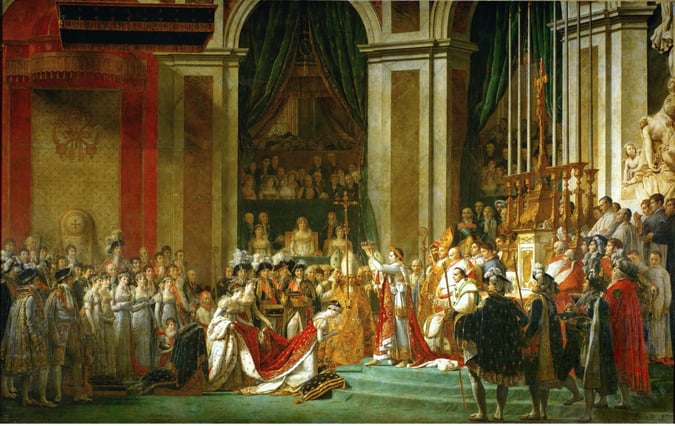
By Jacques-Louis David - art database, Public Domain, https://commons.wikimedia.org/w/index.php?curid=546742 Louvre, Paris
In this grand painting, Napoleon is in the foreground, about to place the crown on Empress Josephine’s head. But dead center in the composition sits a woman in white, enthroned with her attendants. Who is she? Why of course, she is Napoleon’s mother. What makes this especially noteworthy is that Napoleon’s mother didn’t even attend the coronation! Yet her influence is still incontrovertible.
You as a learning experience designer cannot be present when each student experiences your work, but you should remember that your responsibility extends beyond the specific moments you spend building the e-learning. In fact, nothing matters until a user accesses your work. Think less about what you are doing as an author and more about how a learner will experience transformation through your work at some time in the future. Like Napoleon’s mother, you will be there in spirit if not in actuality. I find this idea energizing and inspiring.
Lesson #2: Recognize that each learner is an individual
The Garden Bench by Jacques Joseph Tissot

By James Tissot - http://www.artrenewal.org, Public Domain, https://commons.wikimedia.org/w/index.php?curid=914782 Private Collection
This mother so graciously accommodates the individuality of her children. Each supervised and guided, yet free to experience the world in their own most comfortable ways. She knows that forcing them all into one mold would benefit none.
Our learners approach each learning task with a different background, a different set of skills, and a different set of expectations. Individualized training needs to assess those differences and adapt the experience for each learner as is practically possible. Certainly, there must be some rigor and uniformity in achieving the intended outcomes, but there should be flexibility in how those outcomes are arrived at by each learner.
Lesson #3: Little things matter
The Child’s Bath by Mary Cassatt
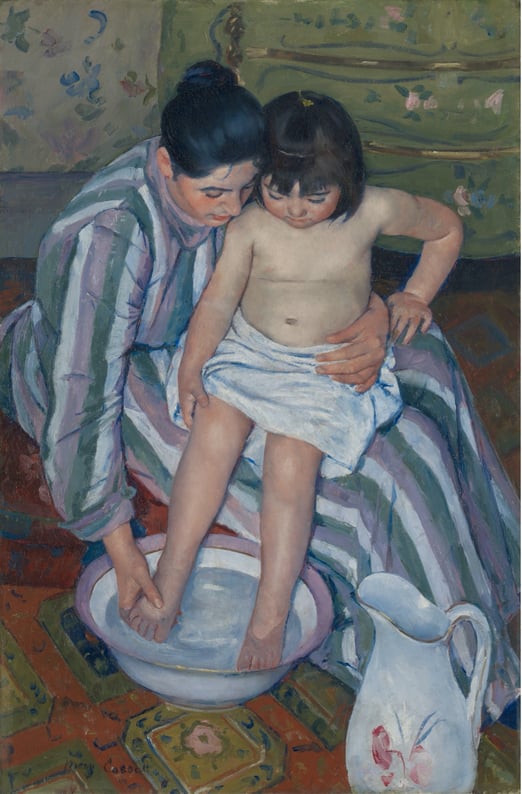
By Mary Cassatt - FQGpjnFFEcrMyw at Google Cultural Institute maximum zoom level, Public Domain, https://commons.wikimedia.org/w/index.php?curid=21909225 The Art Institute of Chicago
Notice how carefully this mother tends to the tiny toes of her little girl. It isn’t enough to just get wet or to have just the upper half of her body washed or to assume cleaning would occur by happenstance. No, equal attention is paid to every part, as she knows that the whole is only composed of many, many small parts.
How often have you by habit glossed over the writing of a feedback message? Or placed an instruction completely thoughtlessly on the screen? Or quickly threw off a narrative not noting your passive voice? None of these things would prevent a module from being published nor block a learner from completing it, but they could have an impact on how effectively your training will impact your learners’ attention and ultimately change their on-the-job performance. Details matter and only you and your team can ensure that all aspects of a training project are created with the highest care.
Lesson #4: Practice is essential
The Music Lesson by Lord Frederic Leighton

Frederic Leighton, 1st Baron Leighton, Public domain, via Wikimedia Commons - Private Collection
This mother knows that supervised practice is a key aspect of learning. The little girl no doubt is making no end of mistakes but is improving with each try as her mother provides mentoring directed toward ways the girl can improve. With time the child will engage in independent practice as her skills develop.
Practice is one of the most important parts of learning, yet so often e-learning designs are focused exclusively on the telling and repeating of information, which is very different from gaining facility with skill through practice. Students should spend more time trying to do a skill or solve a problem, even if it involves a lot of mistakes, rather than passively having content wash over them. Provide lots of feedback and gradually fade it to build skills and confidence.
Lesson #5: Allow unsupervised activity
Camille Monet and a Child in the Garden by Claude Monet
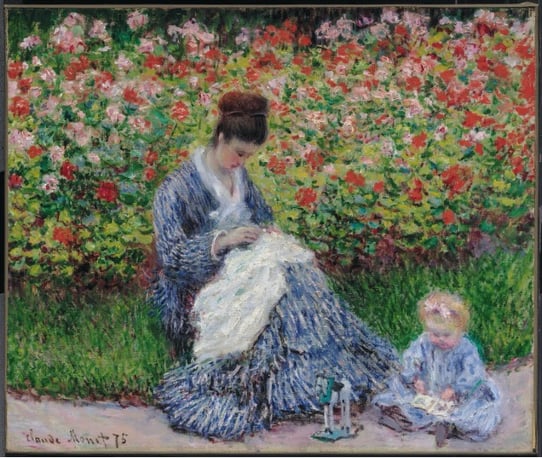
Claude Monet, Public domain - Boston Museum of Fine Arts
Learning benefits from free exploration, a chance to test a hypothesis, a need to experience something directly. Madam Monet clearly understood this. The child has the chance to explore without constant direction. Madam Monet is present but has made it clear to the child that she is free to do what she likes (within reason) without fear of judgment or correction.
Learners in e-learning (and all learning, actually) need that freedom. E-learning modules should provide interactivity merely for the sake of letting the learner try things and test strategies for success without the constant pressure of needing to be “right.” Let your learners take charge and make decisions about their own exploration and learning.
Lesson #6: Assert your authority
Portrait of the 9th Duke of Marlborough and his Family, by John Singer Sargent
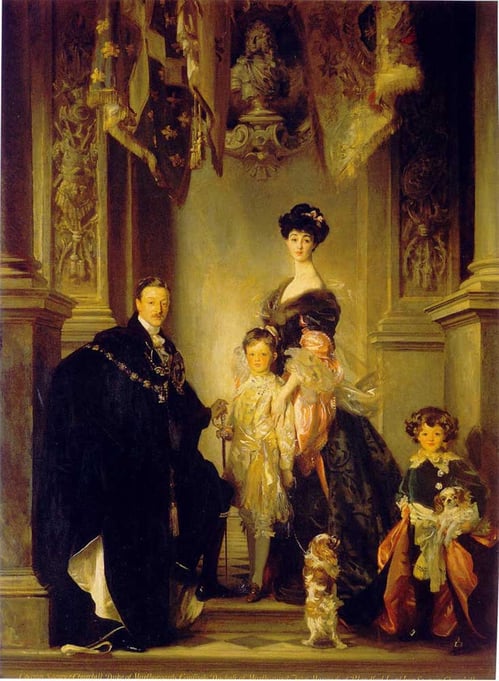
John Singer Sargent, Public Domain via Wikicommons - Private Collection
This regal image is tagged as a portrait of the Ninth Duke of Marlborough. And indeed, the Ninth Duke appears in the composition and was one of the highest-ranking individuals in England. But that really isn’t the message of this portrait. The Duchess, Consuelo Vanderbilt, clearly is the guiding figure of the scene. Ostensibly in the subservient role of spouse, her presence silently communicates her authority over her children, over (or at least on par with her husband), and even commanding the attention of the King Charles spaniel.
Instructional designers and leaders in the L&D community need to assert their presence and knowledge in the training arena. Too often training programs are created based on well-intended but ineffective guidelines and models suggested by administrators and SMEs whose training and experience haven’t developed useful insights into what successful training looks like. While the training may connect with tradition, it is often unrelated to a practical vision of what works in the training arena. We need to be assured in our knowledge and confident enough to demand a voice, even if gently, so that our efforts are directed to usefulness.
Lesson #7: Be ready to withstand challenges
Migrant Mother, by Dorothea Lange

By Dorothea Lange - This image is available from the United States Library of Congress's Prints and Photographs divisionunder the digital ID fsa.8b29516., Public Domain, https://commons.wikimedia.org/w/index.php?curid=52734 - Library of Congress
Hardship is etched into the face of 32-year-old Florence Owens Thompson as captured in this 1936 photo. But even in the face of immense pressure to give up, she holds fast to her children, still striving to bring them to a place of safety.
Certainly, e-learning challenges don’t even begin to approximate the difficulties of homelessness and hunger captured in this photograph. But I take strength in the resolve that is depicted here. It is so easy to abandon good intentions and plans when encountering adversity. When we have only a conviction rather than hard evidence or published research to validate a design claim, one might readily abandon it and take the smoother path of going along, doing what is expected. If we believe training matters, then we must advocate for what we believe will take us to the right place, even if it means encountering and facing down impediments or unproductive approaches.
Lesson #8: Always explore multiple perspectives
My Mother, by David Hockney
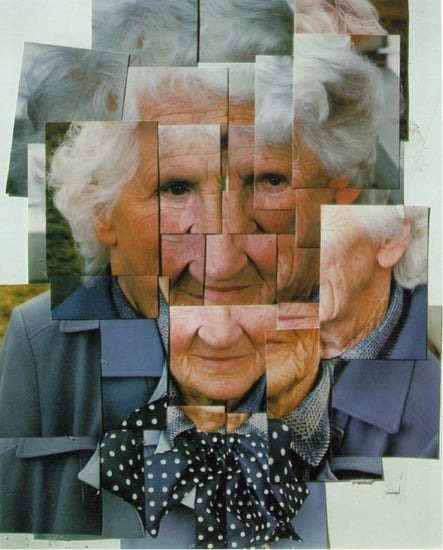
David Hockney
Nothing is ever as simple or one-dimensional as we might assume at first glance. In this photographic collage, David Hockney creates a complex and disarming portrait of his mother, simply by composing a representation of the whole by dividing his viewpoint into many contrasting smaller perspectives and then reassembling them to make a new whole. It’s remarkable how this technique maintains a credible representation of the whole but also forces the viewer to become aware of details that might otherwise be overlooked.
Our job as designers is not necessarily to create a disjointed image, but it is to make sure that we create the opportunity for learners to be immersed in a topic, examine significant factors and elements for themselves, and assemble their own personal and meaningful understanding of the skills needed to succeed. It rarely is useful to just provide a finished “whole” presentation and demand that the learners accept it and remember it at face value. True learning comes through active thinking, personal reflection, and proactive tasks that create meaning and memory.
Lesson #9: Honor effective traditions
Arrangement in Grey and Black #1 (Whistler’s Mother), by James McNeill Whistler
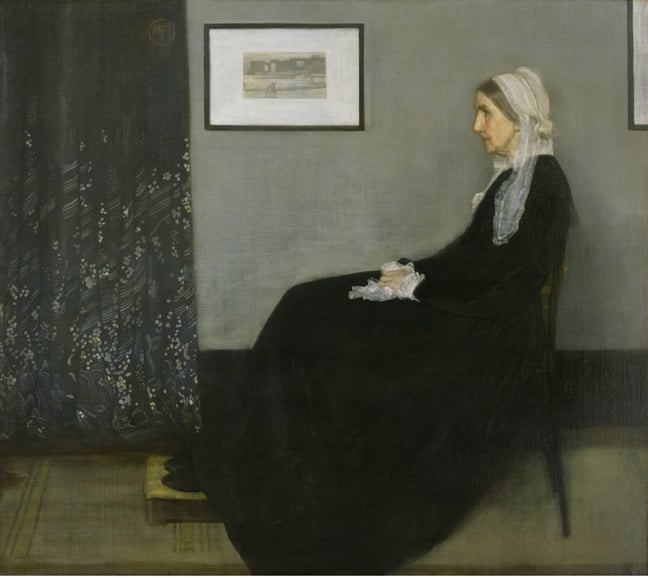
By James Abbott McNeill Whistler - Musée d'Orsay, Public Domain, https://commons.wikimedia.org/w/index.php?curid=17964240 - Musee d’Orsay, Paris
Perhaps the most famous “mother” artwork in the world, this image reminds us of our roots, of traditional values in a changing world, of something of permanence as opposed to quickly changing fads. One can be too wed to the past, but likewise, it can be too tempting to abandon long-held traditions for the sake of some new impermanent movement. Progress depends on embracing the new while carrying the foundation of the success we have enjoyed.
Perhaps because e-learning has been so carelessly developed for so many years, many new practitioners behave as if it is just a brand-new arena in which to work. Whatever is of the moment seems to capture the collective attention. Looking to new technologies and approaches is good, but I fear it is done often without any knowledge or regard for what has been developed before. Some of the earliest and most effective Computer-Based Training (CBT) lessons were enhanced variations on Drill and Practice. And they really worked. But you rarely hear anyone putting that forward as an approach for memorizing facts anymore. Not because it isn’t effective, but more that it has been overlooked in the rush for new approaches. That authoring systems don’t have an easy-to-construct drill and practice framework implies it is not a fundamental valuable structure. In the opposite way, for several years now, games have been at the forefront of design. Games are a useful strategy, but this idea is presented as somehow strikingly original, ignoring the fact that we learned a lot about what makes instructional games work back in the 1980s and prior with pioneering efforts of using computers to teach.
Lesson #10: Seek out and enhance the good and the beautiful
Marie Edwards in her Iris Field, personal family photo collection

No further interpretation needed here. My mother rejoiced in the beauty of nature and the reward of growing living things—plants and people. In all we do, it is important to seek out the good and the beautiful, even in designing e-learning.
On this Mother’s Day, I invite you to take stock of the world around you. Certainly, consider all people engaged in creativity, but particularly think of mothers everywhere—those present and those passed to the Great Beyond. Offer a hug, treasure a memory, or devote a thought of gratitude for the wisdom they have imparted to us.

About the Author: Ethan Edwards
Ethan Edwards draws from more than 30 years of industry experience as an elearning instructional designer and developer. He is responsible for the delivery of the internal and external training and communications that reflect Allen Interactions’ unique perspective on creating Meaningful, Memorable, and Motivational learning solutions backed by the best instructional design and latest technologies.
Comments
What a wonderful set of images, stories, and lessons for us all. Love that the author's own mom finds a place in this as well.
Heather Lalla
5/12/2021, 12:52 PM
BRAVO! Very well written and honest. I appreciate the thoughtful examples and using mothers as your subject. I agree with what is needed to create and develop effective elearning and training.
Would you like to leave a comment?
Related Blog Posts

By: Ethan Edwards | Aug, 2021
Category: Custom Learning

Blog
4 Lenses To Bring e-Learning Instructional Design Into Focus: Part 1 - ...
It’s that time of the year when we in the United States pay tribute to our mothers. My own mother was an incredible source of wisdom and inspiration ...
By: Ethan Edwards | Jan, 2021
Category: Custom Learning

Blog
Pillar III for Transformative e-Learning Instructional Design: Activity
It’s that time of the year when we in the United States pay tribute to our mothers. My own mother was an incredible source of wisdom and inspiration ...
By: Ethan Edwards | Mar, 2021
Category: Custom Learning


Heidi Haugen
5/11/2021, 8:24 PM